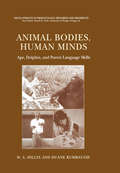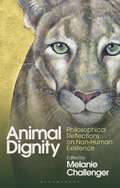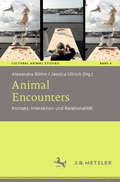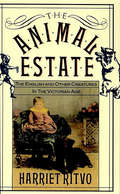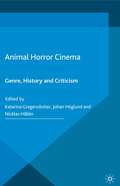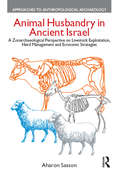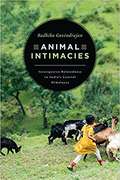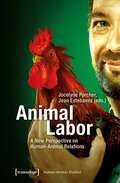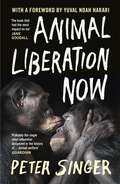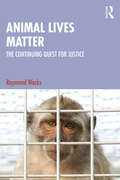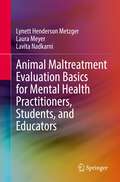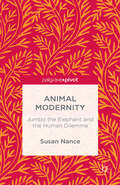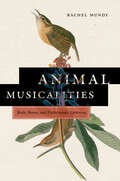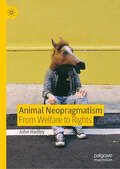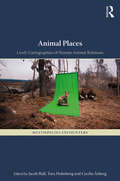- Table View
- List View
Animal: The Autobiography of a Female Body
by Sara PascoeThe hilarious feminist account of the female body by the award-winning comedian** PRE-ORDER SARA PASCOE'S NEW BOOK SEX POWER MONEY NOW**'HILARIOUS' Daily Telegraph'Brilliant' Frankie BoyleSometimes Sara Pascoe confuses herself. She gets wildly and pointlessly jealous. She spends too much time hating her bum. And you know what she hates more than her bum? Her preoccupation with her bum. She's had sexual experiences with boys she wasn't really into, but still got a post-coital crush on them. She's ruined brand-new relationships by immediately imagining them going into reverse. There was so much about her behaviour that Pascoe wanted to understand. So she started researching what makes us - women - tick. And what she read made her eyes fall out of her face. Reader, here is everything science has to tell us about love, sexuality, infidelity, boobs, periods, pubes, broodiness, and clever old fat. Merry Christmas and Hallelujah! Suddenly being a woman doesn't look like such a minefield after all.'Fresh and HONEST' Guardian'Timely and INTELLIGENT' The Times'FUNNY, sad, angry, affronted, engaging and ENLIGHTENING' Stylist
Animal Bodies, Human Minds: Ape, Dolphin, and Parrot Language Skills (Developments in Primatology: Progress and Prospects)
by W.A. Hillix Duane RumbaughSeveral books chronicle attempts, most of them during the last 40 years, to teach animals to communicate with people in a human-designed language. These books have typically treated only one or two species, or even one or a few research projects. We have provided a more encompassing view of this field. We also want to reinforce what other authors, for example Jane Goodall, Sue Savage-Rumbaugh, Penny Patterson, Birute Galdikas, and Roger and Deborah Fouts, so passionately convey about our responsibility for our closest animal kin. This book surveys what was known, or believed about animal language throughout history and prehistory, and summarizes current knowledge and the controversy around it. The authors identify and attempt to settle most of the problems in interpreting the animal behaviours that have been observed in studies of animal language ability.
Animal Cruelty, Antisocial Behaviour, and Aggression: More than a Link (The Palgrave Macmillan Animal Ethics Series)
by Eleonora GulloneDemonstrating that animal cruelty behaviours are another form of antisocial behaviour, alongside human aggression and violence, and almost without exception are carried out by the same individuals this book offers clear recommendations for future research on animal cruelty and future action aimed at prevention.
Animal Dignity: Philosophical Reflections on Non-Human Existence
by Melanie ChallengerHow do we understand the dignity and value of non-human animals? Leading philosophers, ethnologists and writers contribute to this interdisciplinary and wide-ranging account of animal dignity. With a foreword by world-leading primatologist, Dr. Jane Goodall DBE, essays collected here make the case for applying the concept of dignity beyond its usual humanist framework and introduce readers to animal dignity in history, law, science, philosophy, and literature. United in recognizing the dignity of non-human animals, these essays suggest how we might ensure a flourishing environment in times of ecological destruction and climate breakdown. Historians, primatologists, philosophers, novelists and artists approach the concept of animal dignity creatively, offering interpretations that are academically rigorous, alongside ones that are personal and literary. This variety of engagement knits together a fruitful way forward for progressive relations between all species.
Animal Dignity: Philosophical Reflections on Non-Human Existence
How do we understand the dignity and value of non-human animals? Leading philosophers, ethnologists and writers contribute to this interdisciplinary and wide-ranging account of animal dignity. With a foreword by world-leading primatologist, Dr. Jane Goodall DBE, essays collected here make the case for applying the concept of dignity beyond its usual humanist framework and introduce readers to animal dignity in history, law, science, philosophy, and literature. United in recognizing the dignity of non-human animals, these essays suggest how we might ensure a flourishing environment in times of ecological destruction and climate breakdown. Historians, primatologists, philosophers, novelists and artists approach the concept of animal dignity creatively, offering interpretations that are academically rigorous, alongside ones that are personal and literary. This variety of engagement knits together a fruitful way forward for progressive relations between all species.
Animal Encounters: Kontakt, Interaktion und Relationalität (Cultural Animal Studies #4)
by Alexandra Böhm Jessica UllrichDer Band bestimmt den Begriff der Begegnung als eigene, bedeutungstragende Kategorie und fokussiert zum ersten Mal systematisch und historisch Fragen der Interaktion zwischen Menschen und Tieren in Philosophie, Kunst, Literatur und in sozio-kulturellen Praktiken. Einzelanalysen untersuchen die Formen und Funktionen der Interaktion zwischen unterschiedlichen Spezies sowie deren grundlegende Muster, die einerseits von Empathie, Achtsamkeit oder Agency gekennzeichnet sind, bzw. andererseits von Gewalt, Ausgrenzung, Widerständigkeit oder Konfrontation. Damit ergänzt die Publikation die Erforschung der Tier-Mensch-Beziehung um den zentralen Aspekt von ambivalenten Interspezies-Begegnungen, die zugleich destruktives und transformatives Potential offenbaren.
The Animal Estate: The English and Other Creatures in Victorian England
by Harriet RitvoWhen we think about the Victorian age, we usually envision people together with animals: the Queen and her pugs, the sportsman with horses and hounds, the big game hunter with his wild kill, the gentleman farmer with a prize bull. Harriet Ritvo here gives us a vivid picture of how animals figured in English thinking during the nineteenth century and, by extension, how they served as metaphors for human psychological needs and sociopolitical aspirations. Victorian England was a period of burgeoning scientific cattle breeding and newly fashionable dog shows; an age of Empire and big game hunting; an era of reform and reformers that saw the birth of the Royal SPCA. Ritvo examines Victorian thinking about animals in the context of other lines of thought: evolution, class structure, popular science and natural history, imperial domination. The papers and publications of people and organizations concerned with agricultural breeding, veterinary medicine, the world of pets, vivisection and other humane causes, zoos, hunting at home and abroad, all reveal underlying assumptions and deeply held convictions—for example, about Britain’s imperial enterprise, social discipline, and the hierarchy of orders, in nature and in human society. Thus this book contributes a new new topic of inquiry to Victorian studies; its combination of rhetorical analysis with more conventional methods of historical research offers a novel perspective on Victorian culture. And because nineteenth-century attitudes and practices were often the ancestors of contemporary ones, this perspective can also inform modern debates about human–animal interactions.
Animal Horror Cinema: Genre, History and Criticism
by Johan Höglund Katarina Gregersdotter Nicklas HållénThis first full-length scholarly study about animal horror cinema defines the popular subgenre and describes its origin and history in the West. The chapters explore a variety of animal horror films from a number of different perspectives. This is an indispensable study for students and scholars of cinema, horror and animal studies.
Animal Husbandry in Ancient Israel: A Zooarchaeological Perspective on Livestock Exploitation, Herd Management and Economic Strategies
by Aharon SassonAnimals have been used to human advantage for thousands of years. 'Animal Husbandry in Ancient Israel' presents an analysis of caprines and cattle husbandry in the Southern Levantine Bronze and Iron Age. The book employs key methodological approaches - comparative analysis, taphonomy, Geographic Information System spatial analysis, and ethnographic studies - to challenge prevalent views on the Southern Levantine ancient economy. 'Animal Husbandry in Ancient Israel' argues that the key concern of nomadic, rural and urban populations was survival - the common household maintained a self-sufficient economy - rather than profit, specialization or trade. The book will be of value to all those interested in the dynamic relationship between humans and animals in ancient Israel.
Animal Husbandry in Ancient Israel: A Zooarchaeological Perspective on Livestock Exploitation, Herd Management and Economic Strategies
by Aharon SassonAnimals have been used to human advantage for thousands of years. 'Animal Husbandry in Ancient Israel' presents an analysis of caprines and cattle husbandry in the Southern Levantine Bronze and Iron Age. The book employs key methodological approaches - comparative analysis, taphonomy, Geographic Information System spatial analysis, and ethnographic studies - to challenge prevalent views on the Southern Levantine ancient economy. 'Animal Husbandry in Ancient Israel' argues that the key concern of nomadic, rural and urban populations was survival - the common household maintained a self-sufficient economy - rather than profit, specialization or trade. The book will be of value to all those interested in the dynamic relationship between humans and animals in ancient Israel.
Animal Intimacies: Interspecies Relatedness in India's Central Himalayas (Animal Lives)
by Radhika GovindrajanWhat does it mean to live and die in relation to other animals? Animal Intimacies posits this central question alongside the intimate—and intense—moments of care, kinship, violence, politics, indifference, and desire that occur between human and non-human animals. Built on extensive ethnographic fieldwork in the mountain villages of India’s Central Himalayas, Radhika Govindrajan’s book explores the number of ways that human and animal interact to cultivate relationships as interconnected, related beings. Whether it is through the study of the affect and ethics of ritual animal sacrifice, analysis of the right-wing political project of cow-protection, or examination of villagers’ talk about bears who abduct women and have sex with them, Govindrajan illustrates that multispecies relatedness relies on both difference and ineffable affinity between animals. Animal Intimacies breaks substantial new ground in animal studies, and Govindrajan’s detailed portrait of the social, political and religious life of the region will be of interest to cultural anthropologists and scholars of South Asia as well.
Animal Intimacies: Interspecies Relatedness in India's Central Himalayas (Animal Lives)
by Radhika GovindrajanWhat does it mean to live and die in relation to other animals? Animal Intimacies posits this central question alongside the intimate—and intense—moments of care, kinship, violence, politics, indifference, and desire that occur between human and non-human animals. Built on extensive ethnographic fieldwork in the mountain villages of India’s Central Himalayas, Radhika Govindrajan’s book explores the number of ways that human and animal interact to cultivate relationships as interconnected, related beings. Whether it is through the study of the affect and ethics of ritual animal sacrifice, analysis of the right-wing political project of cow-protection, or examination of villagers’ talk about bears who abduct women and have sex with them, Govindrajan illustrates that multispecies relatedness relies on both difference and ineffable affinity between animals. Animal Intimacies breaks substantial new ground in animal studies, and Govindrajan’s detailed portrait of the social, political and religious life of the region will be of interest to cultural anthropologists and scholars of South Asia as well.
Animal Intimacies: Interspecies Relatedness in India's Central Himalayas (Animal Lives)
by Radhika GovindrajanWhat does it mean to live and die in relation to other animals? Animal Intimacies posits this central question alongside the intimate—and intense—moments of care, kinship, violence, politics, indifference, and desire that occur between human and non-human animals. Built on extensive ethnographic fieldwork in the mountain villages of India’s Central Himalayas, Radhika Govindrajan’s book explores the number of ways that human and animal interact to cultivate relationships as interconnected, related beings. Whether it is through the study of the affect and ethics of ritual animal sacrifice, analysis of the right-wing political project of cow-protection, or examination of villagers’ talk about bears who abduct women and have sex with them, Govindrajan illustrates that multispecies relatedness relies on both difference and ineffable affinity between animals. Animal Intimacies breaks substantial new ground in animal studies, and Govindrajan’s detailed portrait of the social, political and religious life of the region will be of interest to cultural anthropologists and scholars of South Asia as well.
Animal Intimacies: Interspecies Relatedness in India's Central Himalayas (Animal Lives)
by Radhika GovindrajanWhat does it mean to live and die in relation to other animals? Animal Intimacies posits this central question alongside the intimate—and intense—moments of care, kinship, violence, politics, indifference, and desire that occur between human and non-human animals. Built on extensive ethnographic fieldwork in the mountain villages of India’s Central Himalayas, Radhika Govindrajan’s book explores the number of ways that human and animal interact to cultivate relationships as interconnected, related beings. Whether it is through the study of the affect and ethics of ritual animal sacrifice, analysis of the right-wing political project of cow-protection, or examination of villagers’ talk about bears who abduct women and have sex with them, Govindrajan illustrates that multispecies relatedness relies on both difference and ineffable affinity between animals. Animal Intimacies breaks substantial new ground in animal studies, and Govindrajan’s detailed portrait of the social, political and religious life of the region will be of interest to cultural anthropologists and scholars of South Asia as well.
Animal Intimacies: Interspecies Relatedness in India's Central Himalayas (Animal Lives)
by Radhika GovindrajanWhat does it mean to live and die in relation to other animals? Animal Intimacies posits this central question alongside the intimate—and intense—moments of care, kinship, violence, politics, indifference, and desire that occur between human and non-human animals. Built on extensive ethnographic fieldwork in the mountain villages of India’s Central Himalayas, Radhika Govindrajan’s book explores the number of ways that human and animal interact to cultivate relationships as interconnected, related beings. Whether it is through the study of the affect and ethics of ritual animal sacrifice, analysis of the right-wing political project of cow-protection, or examination of villagers’ talk about bears who abduct women and have sex with them, Govindrajan illustrates that multispecies relatedness relies on both difference and ineffable affinity between animals. Animal Intimacies breaks substantial new ground in animal studies, and Govindrajan’s detailed portrait of the social, political and religious life of the region will be of interest to cultural anthropologists and scholars of South Asia as well.
Animal Intimacies: Interspecies Relatedness in India's Central Himalayas (Animal Lives)
by Radhika GovindrajanWhat does it mean to live and die in relation to other animals? Animal Intimacies posits this central question alongside the intimate—and intense—moments of care, kinship, violence, politics, indifference, and desire that occur between human and non-human animals. Built on extensive ethnographic fieldwork in the mountain villages of India’s Central Himalayas, Radhika Govindrajan’s book explores the number of ways that human and animal interact to cultivate relationships as interconnected, related beings. Whether it is through the study of the affect and ethics of ritual animal sacrifice, analysis of the right-wing political project of cow-protection, or examination of villagers’ talk about bears who abduct women and have sex with them, Govindrajan illustrates that multispecies relatedness relies on both difference and ineffable affinity between animals. Animal Intimacies breaks substantial new ground in animal studies, and Govindrajan’s detailed portrait of the social, political and religious life of the region will be of interest to cultural anthropologists and scholars of South Asia as well.
Animal Labor: A New Perspective on Human-Animal Relations (Human-Animal Studies #18)
by Jocelyne Porcher Jean EstebanezDo animals work? Is it possible to work with animals without exploiting them? Might animals even be empowered through work? This provocative collection offers original answers to these questions and allows readers to think about human relationships with domestic animals beyond the well-trodden tropes of domination or animal welfare. To study animal work means to look at animals in new ways and to discover in them unsuspected skills and knowledge that open up new ethical and political horizons.
Animal Liberation Now
by Peter SingerThe definitive case for radically rethinking humanity's relationship with other animals - for the good of us all. 'The book that had the most impact on me' JANE GOODALL'Probably the single most influential document in the history of ... animal welfare' GUARDIANIn 1975, Animal Liberation started a global movement when it uncovered the abuse of animals in factory farms and laboratories and showed these horrific practices to be morally indefensible. In the decades since, science has vindicated Peter Singer’s arguments about animal sentience, plant-based diets have become mainstream and his landmark book has changed millions of minds. And yet, for animals, the situation has grown worse.Fully rewritten for the twenty-first century, Animal Liberation Now reveals these new developments and refines its arguments to address the pressing problems of today, including the impact of meat consumption on the climate emergency and the spread of lethal new viruses. A book of galvanising power and importance, it shows that the need to radically rethink our relationship with animals is more pressing than ever.'Will motivate a new generation of readers who are resolutely committed to creating a just society for all' JOAQUIN PHOENIX'The indispensable foundational text for the movement, new and updated' J. M. COETZEE'One the most important books of the last 100 years' ECOLOGIST
Animal Lives Matter: The Continuing Quest for Justice
by Raymond WacksAnimal Lives Matter provides a comprehensive analysis of the legal, philosophical, and ethical aspects of animal rights. It argues that the subject extends beyond the matter of our obligations towards animals, to include our wider responsibilities for protecting the environment. Drawing on numerous moral, political, legal, religious, and philosophical theories including utilitarianism, deontology, rights theory, social contractarianism, and the capabilities approach, the author meticulously examines the questions of sentience, speciesism, personhood, and human exceptionalism. Lucid, nuanced, and academically rigorous, this important book will be an essential resource for scholars of law, politics, philosophy, ethics, as well as policy makers and the general reader.
Animal Lives Matter: The Continuing Quest for Justice
by Raymond WacksAnimal Lives Matter provides a comprehensive analysis of the legal, philosophical, and ethical aspects of animal rights. It argues that the subject extends beyond the matter of our obligations towards animals, to include our wider responsibilities for protecting the environment. Drawing on numerous moral, political, legal, religious, and philosophical theories including utilitarianism, deontology, rights theory, social contractarianism, and the capabilities approach, the author meticulously examines the questions of sentience, speciesism, personhood, and human exceptionalism. Lucid, nuanced, and academically rigorous, this important book will be an essential resource for scholars of law, politics, philosophy, ethics, as well as policy makers and the general reader.
Animal Maltreatment Evaluation Basics for Mental Health Practitioners, Students, and Educators
by Lynett Henderson Metzger Laura Meyer Lavita NadkarniThis book provides a brief introduction to the growing field of animal maltreatment evaluation and treatment, with a special emphasis on clinical training from a forensic psychology perspective. Geared toward mental health practitioners, students, and educators, this broad overview focuses on foundational legal concepts, applications in clinical and psycholegal settings, and emerging perspectives on effective evaluation and treatment. The authors provide practical guidance around “real world” scenarios through the use of clinical case vignettes, highlighting the complexities and need for culturally- and psychologically-informed care in these cases. Key topics include forensic animal maltreatment evaluations (or FAMEs); implications for best practices; challenges for providers, trainees, and supervisors; and future directions for the field.
Animal Modernity: Jumbo The Elephant And The Human Dilemma
by Susan NanceThe concept of 'modernity' is central to many disciplines, but what is modernity to animals? Susan Nance answers this question through a radical reinterpretation of the life of Jumbo the elephant. In the 1880s, consumers, the media, zoos, circuses and taxidermists, and (unknowingly) Jumbo himself, transformed the elephant from an orphan of the global ivory trade and zoo captive into a distracting international celebrity. Citizens on two continents imaged Jumbo as a sentient individual and pet, but were aghast when he died in an industrial accident and his remains were absorbed by the taxidermic and animal rendering industries reserved for anonymous animals. The case of Jumbo exposed the 'human dilemma' of modern living, wherein people celebrated individual animals to cope or distract themselves from the wholesale slaughter of animals required by modern consumerism.
Animal Musicalities: Birds, Beasts, and Evolutionary Listening (Music / Culture)
by Rachel MundyOver the past century and a half, the voices and bodies of animals have been used by scientists and music experts as a benchmark for measures of natural difference. Animal Musicalities traces music's taxonomies from Darwin to digital bird guides to show how animal song has become the starting point for enduring evaluations of species, races, and cultures. By examining the influential efforts made by a small group of men and women to define human diversity in relation to animal voices, this book raises profound questions about the creation of modern human identity, and the foundations of modern humanism.
Animal Neopragmatism: From Welfare to Rights
by John HadleyThis book affords a neopragmatic theory of animal ethics, taking its lead from American Pragmatism to place language at the centre of philosophical analysis. Following a method traceable to Dewey, Wittgenstein and Rorty, Hadley argues that many enduring puzzles about human interactions with animals can be ‘dissolved’ by understanding why people use terms like dignity, respect, naturalness, and inherent value. Hadley shifts the debate about animal welfare and rights from its current focus upon contentious claims about value and animal mindedness, to the vocabulary people use to express their concern for the suffering and lives of animals. With its emphasis on public concern for animals, animal neopragmatism is a uniquely progressive and democratic theory of animal ethics.
Animal Places: Lively Cartographies of Human-Animal Relations (Multispecies Encounters)
by Jacob Bull Tora Holmberg Cecilia ÅsbergNonhuman animals are ubiquitous to our ‘human’ societies. Interdisciplinary human/animal research has - for 50 years - drawn attention to how animals are ever-present in what we think of as human spaces and cultures. Our societies are built with animals and through all kinds of multispecies interactions. From public spaces and laboratories to homes, farms and in the ‘wilderness’; human and nonhuman animals meet to make space and place together, through webs of power relations. However, the very spaces of these interactions are not mute or passive themselves. The spaces where species meet matter, and shape human/animal relations. This book takes as its starting point the relationship between place and human/animal interaction. It brings together the work of leading scholars in human/animal studies, from a variety of disciplinary and interdisciplinary backgrounds. With a distinct focus on place, physical space and biocultural geography, the authors of this volume consider the ways in which space, human and nonhuman animals co-constitute each other, how they make spaces together, produce meaning around them, struggle over access, how these places are storied and how stories of spaces matter. Presenting studies thematically and including a variety of nonhuman creatures in a range of settings, this book delivers new understandings of the importance of nonhuman animals to understandings of place - and the role of places in shaping our interactions with nonhuman creatures. As pets, as laboratory animals, as exhibits, as parasites, as livestock, as quarry, as victims of disaster or objects of folklore, this book offers insights into human/animal intermingling at locales and settings of great relevance to many areas of research, including geography, sociology, science and technology studies, gender studies, history and anthropology. This book meets the evolving interest in human/animal interaction, anthrozoology, and the environmental humanities in relation to the research on space and place that currently informs the humanities and the social sciences.

